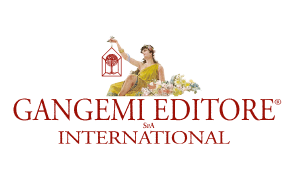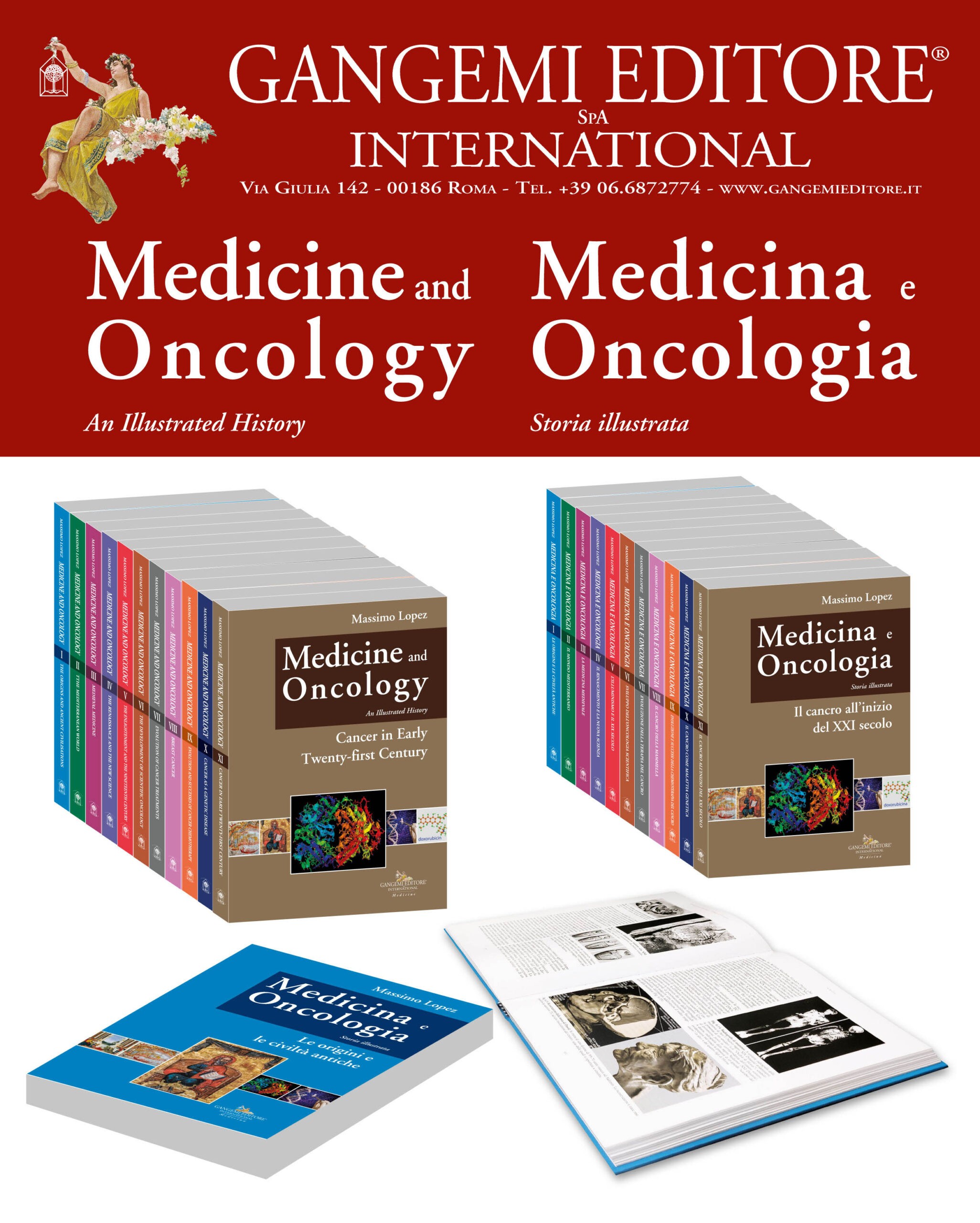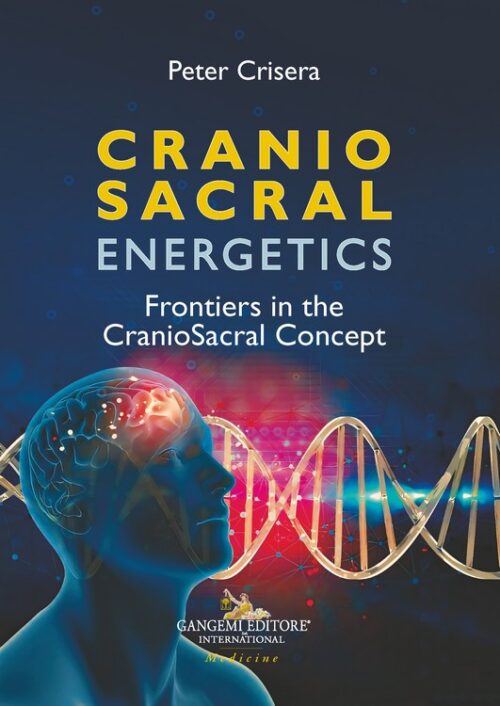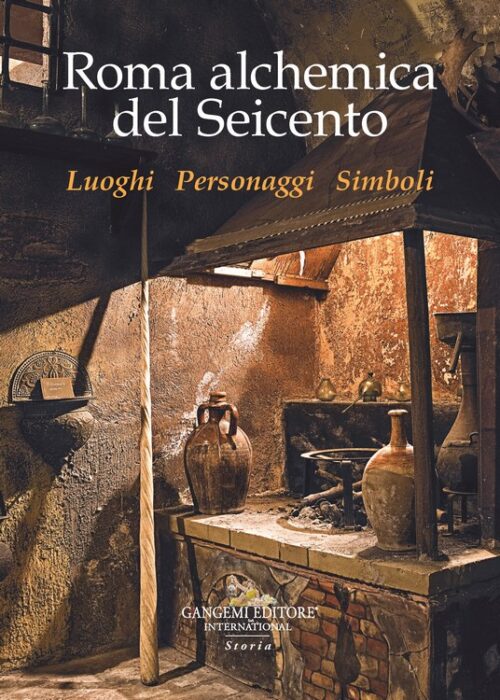Medicine and Oncology. An illustrated history
11 volumes
Autori: Lopez Massimo
Full English text
Formato: 21 x 29,7 cm
Legatura: Cartonato
Pagine: 2584
Anno edizione: 2023
ISBN: 9788849250510
EAN: 9788849250510
UB. INT. :
Contenuto
Massimo Lopez was Director of the Division of Medical Oncology of the “Regina Elena” Institute for Cancer Research in Rome and Professor of Oncology at the 1st School of Specialisation in Oncology at “Sapienza” University, Rome. He has published over 200 articles in the most important scientific journals in Italy and abroad and written several books, including a monograph on breast cancer, one on GIST, and the manual of practical medical oncology that bears his name.
Plan of the Work in 11 volumes
978-88-492-3842-6 Volume I The Origins and Ancient Civilisations
A history of medicine and oncology from its origins to the present day – as envisaged in this eleven-volume project – has never before been written. By placing medicine and oncology into the broader framework of general history and humanist studies this project not only presents the facts but also their significance, thus providing valuable information about the major role played by medical sciences in the development of humanity. Although medical literature contains excellent, but albeit outdated histories of medicine, there are no books on the global history of oncology, in particular, ones which provide a comprehensive overview of the integration between these two disciplines. This first volume outlines the history of medicine and oncology from the origins of life to the development of society in Mesopotamia, Egypt, India, Imperial China and the pre-Columbian Americas. Scientifically accurate and fluidly written, the book combines medical data with numerous illustrations ranging from the ancient graffiti found in caves to the exquisite objects handmade by Ancient Civilisations; all these images visually represent the first steps taken in the field of medicine. The books in this project are not only authoritative texts available for consultation by scholars of medicine and oncology, they also provide interested readers the opportunity to trace the evolution of modern ideas regarding health and the treatment of illnesses, including cancer.
978-88-492-3843-3 Volume II The Mediterranean World
While Mesopotamia was the cradle of the first great civilisation (mid-fourth century BC), Greece was the cradle of medicine as a science. Down through the centuries its strong philosophical and scientific roots nourished its evolution and contributed to the continuous yielding of abundant fruit. The assimilation of the Greek art of medicine, initially in the Latin world of central Italy and later western Europe, is one of the most extraordinary events in the history of medicine since it represents the foundations of the medical tradition throughout the western world. Without this assimilation Greek medicine would historically be confined to the period in which it originally emerged, and with it Hippocrates and Galen. Instead Greek medical theories continued to be studied, debated and applied in the Latin world, at least until the nineteenth century, and the Hippocratic oath is still the symbol of the medical profession. In this second volume of Medicine and Oncology, with its extensive, invaluable iconography, the successful merger between the history of the Greco-Roman civilisation and the history of science is narrated and analysed by the author with the precision of a historian and the competence of a medical researcher. Comprehension of the indissoluble bonds between antiquity and the modern world is crucial to understand the evolution of medicine, because, as stated by Goethe “He who cannot draw on three thousand years of history is living from hand to mouth, and will remain in the dark, inexperienced, living from day to day”.
978-88-492-3844-0 Volume III Medieval Medicine
For many years the Middle Ages were considered to be a period characterized by the collapse of the Greek-Roman civilisation, urban depopulation, castles and sombre cathedrals, abbeys and monasteries where the literate men and women were confined. Teaching and practice of Hippocratic-Galenic scientific medicine, as well as the medical thread that had been woven in previous centuries, threatened of being overwhelmed by the fall of the Western Roman Empire. But Galen succeeded in surviving since, like Aristotle, he had an answer for everything and both were accepted by the Christian world. Early medieval medicine was not as brilliant as that practiced during the period of the “divine Galen”, but Greek and Latin medical manuscripts were nevertheless preserved, studied and copied. With the advent of Islam they were translated into Arabic and, in the subsequent Latin version, they formed the foundation of the science and philosophy in Europe starting in the 11th century. That period also saw the rebirth of rational medicine, first in the Medical School of Salerno and then in the universities and hospitals. This volume of Medicine and Oncology presents a captivating story written with scientific rigour and accuracy in a simple and flowing prose. The book is an inexhaustible mine of information about the medical thought of over a millennium, as well as a feast for the eyes with its elegant illustrations. Like the previous volumes, it is addressed to doctors, scholars, and all those who are interested in this subject and wish to learn more.
978-88-492-3845-7 Volume IV The Renaissance and The New Science
From the 14th century to the end of the 16th century, the social and cultural life of Europe was pervaded by a profound renewal, originating in Italy, which brought the arts and humanities to reach levels unknown for more than a millennium. It was said with enthusiasm that glory would be achieved by removing the rust of the medieval period and emulating the ancients. New inventions, including the printing press, helped to change the basis of culture: books multiplied, and educators were happy to circulate them. Illustrated herbals flourished and, in the rebirth of anatomy, the images of the human body in Vesalius’ Fabrica still inspire admiration for their shapes and details to this day. In the 17th century a fundamental contribution to the advancement of medicine was made by Harvey with the discovery of the circulation of blood, not to mention the contribution made to the definition of science and the experimental method by Galileo, Bacon and Descartes. Great innovators also emerged in chemistry, in microscopic anatomy, and in the definition of the physiology of the organism and diseases. This was the era when the scientific revolution in many fields of knowledge put an end to the Ptolemaic conception of the Universe and Aristotelian physics; it brought out a more realistic vision of nature and the human body; it profoundly cracked the foundations of traditional Galenic medicine and created the conditions for its complete dismantling in the 18th century. The description of these events in the fourth volume of Medicine and Oncology presents us with the extraordinary story of the beginning of modern medicine in the usual fluent style and with numerous illustrations that do not decorate but enlighten the text.
978-88-492-3846-4 Volume V The Enlightenment and The Nineteenth Century
In the 18th century, often referred to as the “century of revolutions”, we witnessed an extraordinary development of science, which began with the formulation of Newton’s principles which are still largely at the basis of our worldview today. The natural sciences were reorganised, with the proposal of zoological and botanical taxonomies, and medicine began to become more scientific with the formulation of great interpretative systems, the birth of a chemistry definitively separate from alchemy, the first research on electrical and physiological phenomena, the innovative interpretation of the nature of disease processes and the characterisation of many specific diseases. However, it was in the 19th century that medicine definitively evolved into science and technology with the invention of the stethoscope, the discovery of anaesthesia, antisepsis and asepsis, vaccines and serotherapy, with the microscopic analysis of tissues and the identification of the cell as the fundamental element of living matter. The interpretative paradigm of alterations in the human body changes and the therapeutic approach shifts with the introduction of chemotherapy and the improvement of surgical techniques. In the fifth volume of Medicine and Oncology, the history of the evolution of the events and concepts that led to the affirmation of modern medicine is also presented through the stories of men and women who, with self-sacrifice and determination, charted the paths to success. The style is the same: simple, flowing, and accessible to all those who are interested in the formation of modern ideas on health and disease. And as always the wonderful illustrations perfectly complement the text.
978-88-492-3847-1 Volume VI The Development of Scientific Oncology
Although described as early as the 5th century BC, for more than two millennia tumours were generally referred to by vague and imprecise terminology that was confusing and prevented them from being properly characterised. It was not until the 18th century that interest in neoplastic diseases began to intensify, making contributions that furthered the development of knowledge in the 19th century. Progress was made in every area of oncology: at the conceptual level with a more scientifically correct approach; at the morphological level with a better macroscopic and microscopic characterisation of tumours; at the classificatory level with a clear separation between carcinomas and sarcomas and with the identification of several nosologically distinct histotypes; at the aetiological level with the discovery of carcinogenic factors and their mechanism of action; at the biological level with the definition of the nature of cancer and the mechanisms underlying its local and distant spread; at the therapeutic level with the considerable progress of surgery which, thanks to the discovery of general anaesthesia and antisepsis, was able to develop radical operations, finally offering patients the real hope of being able to eradicate a disease that for many centuries had disarmed physicians, believing it to be incurable. Initially, medical therapy was unable to make a significant contribution, but at the end of the 19th century the discovery of X-rays and radium provided another effective treatment modality: radiotherapy. In the sixth volume of Medicine and Oncology, the development of scientific oncology is presented with elegant illustrations, in the usual simple and flowing style, to all those who want to know as the age-old dream of curing cancer was turned into a real possibility.
978-88-492-3848-8 Volume VII Evolution of Cancer Treatments
While laboratory research in the second half of the 19th century contributed to providing physicians with new means to improve clinical practice, the transition period from the 19th to the 20th century was crucial in changing the face of medicine and making oncology a discipline that could finally be based on truly effective therapeutic modalities. Anaesthesia and antisepsis greatly broadened the horizons of surgery, allowing for the radical removal of neoplastic processes in any part of the body. The discovery of X-rays and radium provided a new weapon against cancer – radiotherapy – while improved laboratory techniques made hormonal agents increasingly effective in the treatment of hormone-dependent cancers, eliminating the need for physically and psychologically demanding operations such as ovariectomy and orchiectomy. These therapeutic modalities – together with chemotherapy – have expanded the range of treatable cancers, even with curative intent, but the greatest surprise has come from the extraordinary success of cancer immunotherapy. A better understanding of the interactions between host and tumour has made it possible to remove inhibitory mechanisms – to allow immunodepressed cells to perform their full function – and to modify T lymphocytes, enabling them to recognise antigens directly and become active. This has enabled the control, often over a long period of time, of numerous neoplasms, including some that until recently were still resistant to available treatments. The seventh volume of Medicine and Oncology presents these fascinating advances in a flowing and accessible manner, complemented by many vivid illustrations.
978-88-492-3849-5 Volume VIII Breast Cancer
The first to describe breast cancer were the ancient Egyptians, reporting a case of it in the Edwin Smith papyrus some 3000 years BC. In the millennia that have followed, there has been no era in which it has not been the focus of attention of both doctors and lay people, and its history is punctuated by a myriad of events that have brought hope and disappointment, joy and sorrow, excitement and depression, fear and terror or peace and calm. Conflicting emotions that reflect the conception of the disease, the various treatment methods used and the different results obtained. It is a fascinating story, not only from a human point of view, but also from a scientific one, thanks to the ongoing commitment of dozens of researchers who have made a significant contribution to the advancement of knowledge on the aetiology, pathogenesis, molecular biology and genetics of the disease, with clinical and therapeutic implications so extraordinary as to completely transform the very face of this malignancy. Breast cancer – once almost always fatal – is nowadays a curable neoplasm in the vast majority of cases, if diagnosed early and treated correctly. Yet even in advanced stages – at least for some subgroups – there is the possibility of cure or conversion into a chronic disease compatible with longterm survival. Current research is advancing rapidly, encouraged by numerous initiatives motivated by the social and psychological impact of the disease and by technological advances. The aim of volume VIII of Medicine and Oncology, decorated with numerous figures that contribute to a better understanding of the text, is to retrace the progress of this age-old disease over the centuries, highlighting its human aspects, scientific achievements as well as future prospects.
978-88-492-3850-1 Volume IX Evolution and Successes of Cancer Chemotherapy
We have known about cancer since the earliest times, and man has always tried to eliminate or cure it with the means at his disposal. Before chemotherapy, he used medicinal herbs and chemicals of various kinds, with results that were generally of little or no efficacy. Modern chemotherapy originated in the early 1940s and is linked to studies conducted in the United States on several toxic substances in anticipation of their possible use by the Germans for the purposes of warfare. The first drug was nitrogen mustard, which in combination chemotherapy regimens proved capable of curing certain neoplasms. The development of other agents contributed significantly to curative drug combinations, greatly increasing the number of advanced cancers curable by chemotherapy (childhood acute leukaemia, Hodgkin’s lymphoma, non-Hodgkin’s lymphomas, testicular tumours, certain paediatric solid tumours). In other cases, if a definitive cure could not be achieved, patients’ survival was considerably prolonged, turning a disease generally characterised by a rapidly lethal course into a chronic one. These results were achieved thanks to the perspicacity and perseverance of numerous young researchers; the conduct of thorough clinical trials; the development of the rational basis for chemotherapy and drugs that counteract its side effects; and the availability of accurate statistical analyses. A significant contribution has also been made by nanotechnology. Volume IX of Medicine and Oncology is an account of the extraordinary and fascinating development of cancer chemotherapy, the spirit of research and the difficulties encountered, and the achievement of often unexpected successes. As always, with the usual accessible style and numerous explanatory figures.
978-88-492-3851-8 Volume X Cancer as a Genetic Disease
After centuries of speculation and conjecture about the nature of cancer, we now know that it is a genetic disease, in the sense that it is caused by the alteration of certain genes. The path that led to this conclusion began in the second half of the 19th century with the theory of evolution put forward by Charles Darwin and the formulation of laws on the transmission of hereditary traits by Gregory Mendel. However, it was the discovery in 1953 of the double helix structure of DNA that was the decisive turning point that, by fostering the development of molecular biology, triggered a series of research studies into the genetic characteristics of tumours that made it possible to clarify the fundamental mechanisms underlying their genesis and progression. Today, we know about the role of oncogenes, tumour suppressor genes, DNA damage repair genes, growth factors, receptors, non-receptor oncoproteins, signal transduction pathways, the microenvironment surrounding the tumour, as well as epigenetic factors. Yet such findings would seem dry without hearing of the events behind them, of the researchers’ commitment and perseverance in conducting long and difficult studies, of their insights, joys and frustrations, of their ability to put together disparate pieces of the puzzle and make sense of things. It is one of the most fascinating tales in oncology that has unfolded through complicated journeys, often ending with the awarding of the “Prize of Prizes” – the Nobel – to young and enthusiastic researchers. This tale is outlined in Volume X of Medicine and Oncology with passionate participation by the author, who has managed to make even the most complicated concepts easy to understand, often using highly representative illustrations.
978-88-492-3852-5 Volume XI Cancer in Early Twenty-first Century
The interpretation of cancer as a genetic disease has provided the rational basis for developing new weapons to fight it, by searching for molecular alterations that play a key role in the neoplastic transformation of the cell and the maintenance of its proliferative activity. At the turn of this century, molecular cancer therapy emerged, making a neoplasm with a generally fatal course – chronic myeloid leukaemia – into a disease compatible with an almost normal life. Today, some 20 years on, there are now many cancers that can benefit from personalised treatments with significantly prolonged patient survival. With volume XI of Medicine and Oncology, the long journey that began with the dawn of life has come to an end: an impassioned journey that has recounted the many achievements over the centuries to preserve human health, and which concludes with an examination of the most recent and spectacular therapeutic advances, obtained thanks to the possibility – provided by new and sophisticated technologies – of sequencing the human genome and, therefore, of studying neoplastic disease in greater depth. Nevertheless, research does not stop here. The foundations have now been laid to trust in new advances in improving the specificity of molecularly targeted drugs and in the development of therapeutic mRNA cancer vaccines, in the wake of the success of preventive vaccines against COVID-19. Everything is presented with the usual lucid clarity of exposition, aided by numerous images that enhance the text, making it even easier to understand.
Parole chiave
Condividi su














